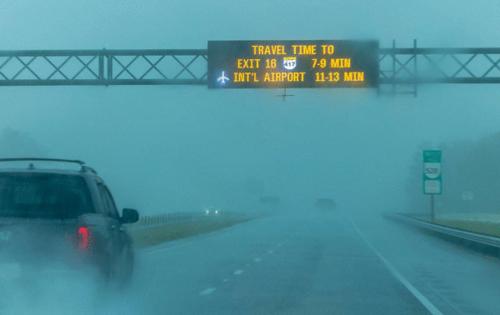Why monster hurricanes like Milton are happening in the Gulf. It's not geoengineering
Published in News & Features
MIAMI — Hurricanes have always happened, at least for as long as we have records. But two major hurricanes in just two weeks, both hitting the Florida Gulf Coast, is highly unusual if not quite unprecedented. In 2004, two major hurricanes, Frances and Jeanne, made landfall 21 days apart in the exact same spot, Hutchinson Island.
But on barely moderated social media, it seems weird enough that people are unintentionally spreading false statements, known as misinformation. Others do so intentionally (known as disinformation), often to get more followers on social media and help monetize their profiles.
It’s gotten bad enough that both Republicans and Democrats have started to push back on the same kind of mis- and disinformation, even when it comes from their own ranks.
Gov. Ron DeSantis, when asked about misinformation spreading on the internet about Hurricane Milton in Florida, sharply pushed back at what he said was simply a bid for attention not based in reality.
“Most people are wise to this. We live in an era where if you put out crap online you can get a lot of people to share it and monetize it,” he said.
“Be careful about the nonsense that gets circulated. Be aware that the more titillating it is, the more likely somebody is making money off it. And they don’t really give a damn about the well-being and safety of the people that are actually in the eye of this storm.”
President Joe Biden also called it “un-American” to spread disinformation, which can undermine recovery efforts. “It’s not who the hell we are,” he said.
To get real answers on some of the questions swirling around Hurricanes Helene and Milton, the Herald spoke to scientists and experts who’ve dedicated their careers to meteorology, atmospheric science, tropical cyclones, and hurricanes.
Why did Milton form?
Hurricanes are normal, an extreme weather event that has been around for as long as we know. Some were likely to hit Florida this season, just like in past hurricane seasons.
“Especially for the Panhandle, October is the most active month,” says meteorologist and hurricane expert Athena Masson.
Milton also formed in the Gulf of Mexico, a sort of “red zone” as it has relatively warm water —hurricanes need water of at least 80 degrees to form — and what’s referred to as a low vertical wind shear. Those are winds that, at vastly different altitudes, move in different directions and at high levels can put the brakes on storm intensity. Because the Gulf is surrounded by land, storms will eventually make landfall. “It’s like getting in a bathtub and rocking back and forth,” Masson says.
Milton, however, gained so much strength in part because it formed over an abnormally warm Gulf of Mexico, and the warmer the water, the higher the chances a hurricane intensifies. At one point, Milton’s barometric pressure — a measure of storm intensity — hit 897 millibars, making it the fourth strongest hurricane on record. Only five hurricanes in records have dipped below 900 in official records dating back more than 170 years.
Why is the Gulf so warm?
The Gulf was 2.9 degrees hotter than 30-year-average during this time of the year, and though a fluke can occur in any given year. “It’s this constant above average that we’ve seen, so we know it’s not just a fluke,” Shel Winkley says.
This warming is in large part a result of our greenhouse gas emissions – from CO2 to methane – which have created a heat-trapping and ocean-warming blanket around the planet.
Scientists have attributed the role climate change has played in all this: “The water in which Milton developed and then rapidly intensified was about 400 times more likely because of climate change, so we can see how much of a fingerprint climate has,” says Winkley.
How is this happening now, just after Helene?
“This really just comes down to bad luck,” says Brian McNoldy, an expert in atmospheric science who specializes in tropical storms and hurricanes at the University of Miami.
Florida has actually had worse luck. In 2004, four hurricanes slammed the state in just six weeks between August and September. Charley, Frances, Ivan and Jeanne killed more than 100 people and caused some $50 billion in combined damages.
Storms forming around the same time also isn’t unusual — in 2005, for example, Hurricane Katrina, the deadliest to ever hit the US, with 1,392 deaths, formed at the same time as Rita and Wilma, which also reached Cat 5 status.
“So that is not unusual,” Winkley says, “but what is unusual is that both (Helene and Milton) were able to rapidly intensify and how strong they were able to get in such a short amount of time,” he says, adding that this intensity was in part due to the 86-degree warm waters, which ties back to our fossil fuel emissions.
Can we ‘geoengineer’ hurricanes?
While it’d be great if we could, we simply can’t, says Masson.
Geoengineering describes large, technological, and hugely controversial interventions that could, at some point in the future, help cool our over-heating planet. Scientists are experimenting with technology that could brighten clouds or suck carbon, which accounts for 75 percent of planet-warming greenhouse gases, out of the atmosphere. Both are nascent, and neither are currently able to weaken the effects of climate change.
The closest we might have come to engineer the weather is to destroy comparably tiny clouds, for example, for the opening ceremony of the 2008 Olympic Games in Beijing, Masson says.
But hurricanes are massive weather systems, not simple clouds, and they are hundreds of miles wide. Even if it was possible “we’d destroy the entire atmosphere,” Masson says. As a meteorologist, she committed her life “to protect lives and give the best possible updates. If we had that sort of technology, we would be telling people.”
Can we weaken hurricanes, or steer them?
No. There are a lot of theories on what could work out there, atmospheric scientist McNoldy says, but the sheer force of a hurricane is just too mighty to stop, steer, or control in any way.
Back in World War 2, the idea of weakening a hurricane with nuclear bombs was first floated around, “but the equivalent energy in a hurricane dwarfs anything we can do with nuclear weapons,” McNoldy says.
Around the eye of Hurricane Andrew, which destroyed more than 63,000 homes in south Florida in 1992, the heat energy released was 5,000 times the heat and electrical power generation of nuclear power station Turkey Point.
“People come up with these ideas without knowing what a hurricane is,” and though they might seem plausible at first glance, “the scale is impossible.”
---------
(Miami Herald Hurricane and Climate Reporter Alex Harris contributed to this story.)
©2024 Miami Herald. Visit at miamiherald.com. Distributed by Tribune Content Agency, LLC.







Comments